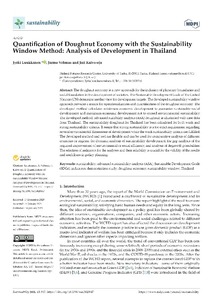| dc.contributor.author | Kaivo-oja Jari | |
| dc.contributor.author | Vehmas Jarmo | |
| dc.contributor.author | Luukkanen Jyrki | |
| dc.date.accessioned | 2022-10-27T11:50:55Z | |
| dc.date.available | 2022-10-27T11:50:55Z | |
| dc.identifier.uri | https://www.utupub.fi/handle/10024/155355 | |
| dc.description.abstract | <p>The doughnut economy is a new approach for the inclusion of planetary boundaries and social foundation in the development of societies. The Sustainable Development Goals of the United Nations (UN) determine another view for development targets. The developed sustainability window approach provides a means for operationalization and quantification of the doughnut economy. The developed method calculates minimum economic development to guarantee sustainable social development and maximum economic development not to exceed environmental sustainability. The developed method, advanced suitability analysis (ASA) doughnut, is illustrated with case data from Thailand. The sustainability doughnut for Thailand has been calculated for both weak and strong sustainability criteria. It seems that strong sustainability is a too strict requirement regarding several environmental dimensions of development while the weak sustainability criteria are fulfilled. The developed method and tool are flexible and can be used for comparative analysis of different countries or regions, for dynamic analysis of sustainability development, for gap analysis of the required improvement of environmental or social efficiency, and analysis of degrowth possibilities. The selection of indicators for the analyses and their reliability is crucial for the validity of the results and usefulness in policy planning.<br /></p> | |
| dc.language.iso | en | |
| dc.publisher | MDPI | |
| dc.title | Quantification of Doughnut Economy with the Sustainability Window method: Analysis of development in Thailand | |
| dc.identifier.url | https://www.mdpi.com/2071-1050/13/2/847/htm | |
| dc.identifier.urn | URN:NBN:fi-fe2021042821341 | |
| dc.relation.volume | 13 | |
| dc.contributor.organization | fi=tulevaisuuden tutkimuskeskus (FFRC)|en=Finland Futures Research Centre (FFRC)| | |
| dc.contributor.organization-code | 2608900 | |
| dc.converis.publication-id | 51643646 | |
| dc.converis.url | https://research.utu.fi/converis/portal/Publication/51643646 | |
| dc.identifier.jour-issn | 2071-1050 | |
| dc.okm.affiliatedauthor | Luukkanen, Jyrki | |
| dc.okm.affiliatedauthor | Vehmas, Jarmo | |
| dc.okm.affiliatedauthor | Kaivo-oja, Jari | |
| dc.okm.discipline | 1172 Ympäristötiede | fi_FI |
| dc.okm.discipline | 520 Other social sciences | en_GB |
| dc.okm.discipline | 511 Economics | en_GB |
| dc.okm.discipline | 112 Statistics and probability | en_GB |
| dc.okm.discipline | 112 Tilastotiede | fi_FI |
| dc.okm.discipline | 1172 Environmental sciences | en_GB |
| dc.okm.discipline | 511 Kansantaloustiede | fi_FI |
| dc.okm.discipline | 520 Muut yhteiskuntatieteet | fi_FI |
| dc.okm.discipline | 519 Social and economic geography | en_GB |
| dc.okm.discipline | 519 Yhteiskuntamaantiede, talousmaantiede | fi_FI |
| dc.okm.internationalcopublication | not an international co-publication | |
| dc.okm.internationality | International publication | |
| dc.okm.type | Journal article | |
| dc.publisher.country | Switzerland | en_GB |
| dc.publisher.country | Sveitsi | fi_FI |
| dc.publisher.country-code | CH | |
| dc.publisher.place | Basel | |
| dc.relation.articlenumber | 847 | |
| dc.relation.doi | 10.3390/su13020847 | |
| dc.relation.ispartofjournal | Sustainability | |
| dc.relation.issue | 2 | |
| dc.year.issued | 2021 | |
